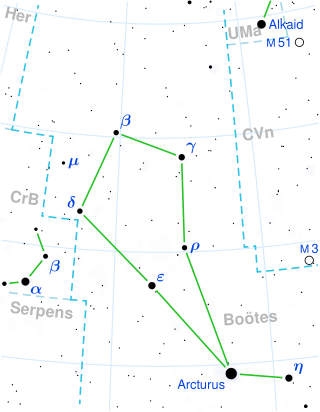Epsilon Boötis
Double star in Boötes From Wikipedia, the free encyclopedia
Epsilon Boötis (ε Boötis, abbreviated Epsilon Boo, ε Boo), officially named Izar (/ˈaɪzɑːr/ EYE-zar),[16] is a binary star in the northern constellation of Boötes. The star system can be viewed with the unaided eye at night, but resolving the pair with a small telescope is challenging; an aperture of 76 mm (3.0 in) or greater is required.[17]
| Observation data Epoch J2000 Equinox J2000 | |
|---|---|
| Constellation | Boötes |
| Right ascension | 14h 44m 59.22s[1] |
| Declination | +27° 04′ 27.2″[1] |
| Apparent magnitude (V) | 2.37[2]/5.12[3] |
| Characteristics | |
| Spectral type | K0 II-III[4] + A2 V[5] |
| U−B color index | +0.73[2] |
| B−V color index | +0.97[2] |
| Astrometry | |
| Radial velocity (Rv) | −16.31[6] km/s |
| Proper motion (μ) | RA: −50.95[1] mas/yr Dec.: +21.07[1] mas/yr |
| Parallax (π) | 13.8267 ± 0.4896 mas[7] |
| Distance | 236 ± 8 ly (72 ± 3 pc) |
| Absolute magnitude (MV) | −1.61[8] |
| Details | |
| A | |
| Mass | 4.6[9] M☉ |
| Radius | 37.61+1.29 −1.38[10] R☉ |
| Luminosity | 652.5±58.7[10] L☉ |
| Surface gravity (log g) | 2.24[10] cgs |
| Temperature | 4,755±46[10] K |
| Metallicity | –0.13[6] |
| Metallicity [Fe/H] | –0.20[11] dex |
| Rotational velocity (v sin i) | 10.9[6] km/s |
| B | |
| Mass | 2.27[12] M☉ |
| Radius | 2.7[12] R☉ |
| Luminosity | 44.8[12] L☉ |
| Surface gravity (log g) | 3.9[12] cgs |
| Temperature | 9,009[12] K |
| Rotational velocity (v sin i) | 123[13] km/s |
| Other designations | |
| A: Izar, HD 129989, HR 5506, SAO 83500[15] | |
| B: HD 129988, HR 5505[3] | |
| Database references | |
| SIMBAD | Epsilon Boo A |
| Epsilon Boo B | |
Nomenclature
Summarize
Perspective

ε Boötis (Latinised to Epsilon Boötis) is the star's Bayer designation.
It bore the traditional names Izar, Mirak and Mizar, and was named Pulcherrima /pəlˈkɛrɪmə/ by Friedrich Georg Wilhelm von Struve.[18] Izar, and Mizar are from the Arabic: إزار ʾizār and مئزر Mi'zar ('kilt like undergarment') and المراق al-maraqq' ('the loins'); Pulcherrima is Latin for 'loveliest'.[19] In 2016, the International Astronomical Union organized a Working Group on Star Names (WGSN)[20] to catalogue and standardize proper names for stars. The WGSN approved the name Izar for this star on 21 August 2016 and it is now so entered in the IAU Catalog of Star Names.[16]
In the catalogue of stars in the Calendarium of Al Achsasi Al Mouakket, this star was designated Mintek al Aoua (منطقة العوّاء minṭáqa al awwa), which was translated into Latin as Cingulum Latratoris, meaning 'belt of barker'.[21]

In Chinese astronomy, 梗河 Gěng Hé ('Celestial Lance'), refers to an asterism consisting of Epsilon Boötis, Sigma Boötis and Rho Boötis.[22] Consequently, the Chinese name for Epsilon Boötis itself is 梗河一 Gěng Hé yī ('the First Star of Celestial Lance').[23]
Properties
Summarize
Perspective

Epsilon Boötis consists of a pair of stars with an angular separation of 2.852 ± 0.014 arcseconds at a position angle of 342.°9 ± 0.°3.[24] The brighter component (A) has an apparent visual magnitude of 2.37,[2] making it readily visible to the naked eye at night. The fainter component (B) is at magnitude 5.12,[3] which by itself would also be visible to the naked eye. Parallax measurements from the Hipparcos astrometry satellite[25][26] put the system at a distance of about 203 light-years (62 parsecs) from the Earth.[1] This means the pair has a projected separation of 185 Astronomical Units, and they orbit each other with a period of at least 1,000 years.[19]
The brighter member has a stellar classification of K0 II-III,[4] which means it is a fairly late-stage star well into its stellar evolution, having already exhausted its supply of hydrogen fuel at the core. With more than four times the mass of the Sun,[9] it has expanded to about 38 times the Sun's radius and is emitting 650 times the luminosity of the Sun. This energy is being radiated from its outer envelope at an effective temperature of 4,755 K,[10] giving it the orange hue of a K-type star.[27]
The companion star has a classification of A2 V,[5] so it is a main sequence star that is generating energy through the thermonuclear fusion of hydrogen at its core. This star is rotating rapidly, with a projected rotational velocity of 123 km/s.[13] It has a surface temperature of about 9,000 K and a radius nearly three times the Sun, leading to a bolometric luminosity 45 times that of the Sun.
By the time the smaller main sequence star reaches the current point of the primary in its evolution, the larger star will have lost much of its mass in a planetary nebula and will have evolved into a white dwarf. The pair will have essentially changed roles: the brighter star becoming the dim dwarf, while the lesser companion will shine as a giant star.[19]
In culture
In 1973, the Scottish astronomer and science fiction writer Duncan Lunan claimed to have managed to interpret a message caught in the 1920s by two Norwegian physicists[28] that, according to his theory, came from a 13,000 year old satellite polar orbiting the Earth known as the Black Knight and sent there by the inhabitants of a planet orbiting Epsilon Boötis.[29] The story was even reported in Time magazine.[30] Lunan later withdrew his Epsilon Boötis theory, presenting proofs against it and clarifying why he was brought to formulate it in the first place, but later revoked his withdrawal.[31]
References
External links
Wikiwand - on
Seamless Wikipedia browsing. On steroids.

